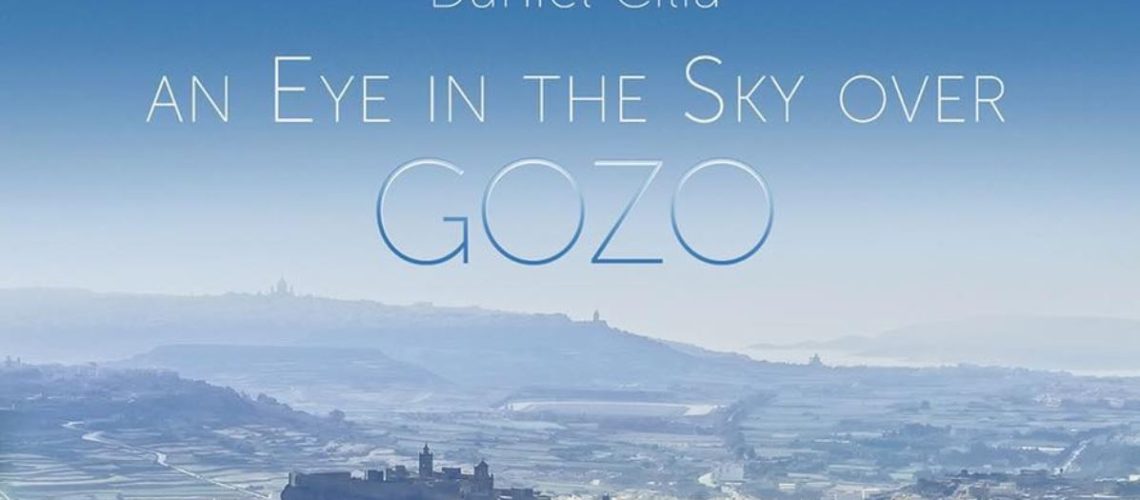Tucked away on the side of St George’s Basilica in Gozo’s Victoria I have just discovered a museum I must have walked past a hundred times before and never noticed and I feel apologetic that I haven’t been shouting about it from the rooftops. I confess I first ventured into the Heart of Gozo/Il-Ħaġar Museum this week, encouraged in by the promise of photos of Gozo from the air by photographer Daniel Cilia using a drone and other aerial techniques. I am so glad I did as I was wowed by the series which ranged from the intimacy of hay bales in a single field to a new slant on panoramic vistas I know and love.
And while the recognisable landscapes are striking, mists wrapping the citadel for example framed by blue sky and green fields, other photographs depict a way of life that harks back to years gone by. These are timeless patterns of man’s behaviour on age-old land and snatches of colour added by human endeavour and local culture – people walk on a dusty road between crops, the corners of painted boats edge into a shot of fisherman’s ripe-tomato-red nets and the brick-red dome of St George’s Basilica in Victoria boasts an impressive dominance as striking from the air as it is from the cafés at the steps at its foot.
As you’d expect, the sea also figures largely alongside the valleys and folds in the landscape, the turquoise of welcoming waters at Mgarr contrasting with a shot of the white of waves skipping directly below as dark blue water curls onto buttermilk rock, the power and unpredictability of the water clear as day.
Other images are yet more intriguing and you need to look again and ponder – and this teasing element is part of the pleasure of this exhibition, adding the challenge of identification to the enjoyment of the striking images. The quarry near Dwejra from directly above could at first glance be cattle amassing in a North African desert, whilst a swirl of rocks is (I think) that currently adorning a patch of coastal land by the salt pans to the North of the island – but if I hadn’t driven past just recently I wouldn’t have known – and a hexagonal patterning on the mosaic floor at the entrance to Ta Pinu is a mere glimpse of the glories of the mosaics at the entrance to this pilgrim’s sanctuary, a mini-labyrinth perhaps representing the route we all take to find spiritual peace.
This Eye of Gozo exhibition is not to be confused with the iconic eye of Osiris painted or carved on the bow of the traditional boats bobbing in the waters here, a symbol said to have been brought to Malta by the Phoenicians the eye of Osiris – a symbol of the ancient god’s protection to keep fishermen safe at sea.
Head upstairs, however, and you’ll find this painted eye captured in a second series of photographs and on screen, Colours of Gozo by Italian Salvatore Iozzi, a select yet powerful exhibition which offers an explicitly rainbow view of Gozo, its joyful nature and its traditions, folklore and festivals. Alongside the gold and blue for which the island is famed and the primary tones of the boats, enjoy a sunset dropping into an evening sea, colourful illuminations, feted saints aloft, paper confetti strewn in the air, and the sky alight with the fireworks for which Gozitan festas are far-famed. Expect too doors standing proud against stone in strong colours, and detailed paintings inside the local churches their pigments aglow. My particular favourites however are the reflections of luzza and dgħajsa in such glorious technicolour even Joseph of dreamcoat-fame would be green with envy. Yes, Gozo is gorgeous and we’re very blessed to be part of it.
‘An Eye in the Sky over Gozo’ runs at Heart of Gozo/Il-Ħaġar Museum, St George’s Square until 20th August and ‘Colours of Gozo’ runs until 20th September 2018.




